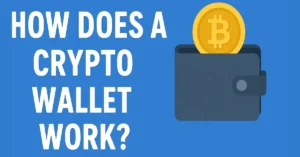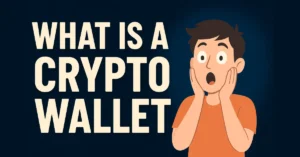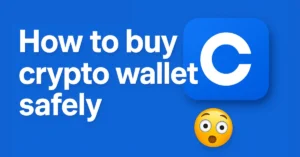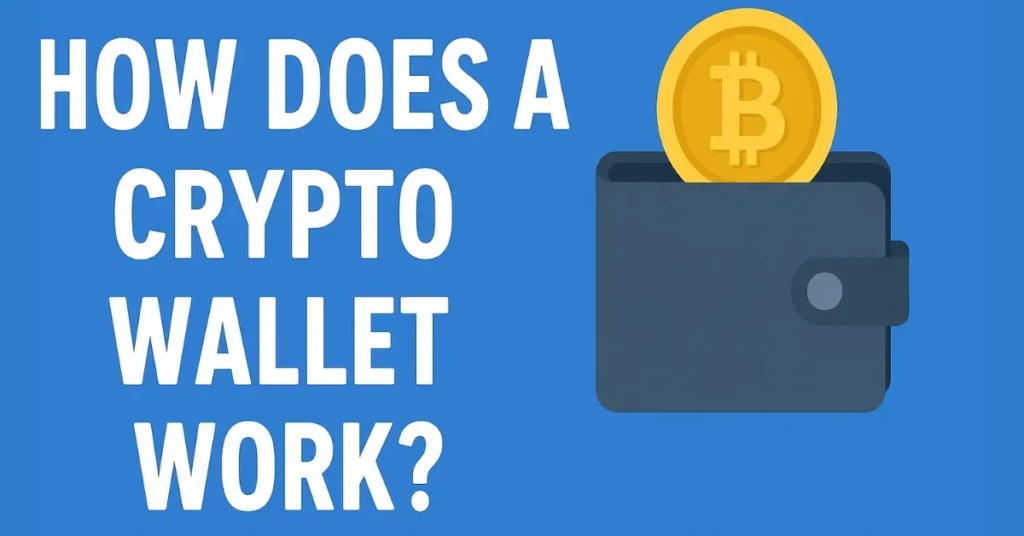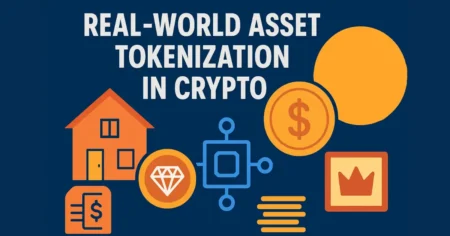How Does Crypto Wallet Work in 2025.
Introduction to Crypto Wallets
If you are stepping into the world of cryptocurrency, the first question that often comes to mind is how do you actually store your coins or tokens. Unlike physical cash that you keep in your wallet or in your pocket, digital currencies need a different kind of storage. This is where a crypto wallet comes in. A crypto wallet is not like the leather wallet you carry around every day. Instead, it is a digital tool that helps you store, send, and receive cryptocurrencies safely.
Think of it as a combination of your bank account and a safe deposit box. Just like your bank account keeps your money secure and allows you to transfer funds when needed, a crypto wallet performs a similar role but in the digital world. It provides you with a way to access your cryptocurrency and use it whenever you want. Without a crypto wallet, it is almost impossible to interact with the world of blockchain technology because it is the only way you can prove ownership of your digital assets.
Many beginners assume that the wallet directly holds their coins. In reality, the wallet does not physically store the cryptocurrency itself. Instead, it stores special keys called public keys and private keys. These keys are like your digital identity. The public key is similar to your account number, which you can share with others so they can send you money. The private key is like your ATM pin, which you should never share with anyone, because it gives full control over your funds.
Using a crypto wallet is the first step toward becoming independent in the crypto space. You will not have to depend on exchanges to hold your money. Instead, you will have full control of your digital assets. This control comes with responsibility, and that is why understanding how a crypto wallet works is very important before you start investing.
What is a Crypto Wallet?
A crypto wallet is a digital tool that allows you to store, send, and receive cryptocurrencies safely. It works as your gateway to the blockchain world where all transactions take place. You can think of it as a digital version of a regular wallet, but instead of holding paper money or coins, it manages your cryptocurrency keys.
The wallet does not actually hold your crypto inside it. Instead, it keeps your private and public keys which give you access to your digital funds on the blockchain. The public key works like your bank account number that you can share with others when you want to receive money. The private key is like your personal pin code, which only you should know because it gives full access to your funds.
Crypto wallets come in different forms such as mobile apps, desktop software, hardware devices, and even simple pieces of paper with printed keys. No matter the type, the main job of the wallet is to connect you with the blockchain and help you manage your assets securely.
If you are new to cryptocurrency, understanding the basics of how wallets work is the first step to protecting your investment and using your digital money with confidence.
You may also like it.
What is a crypto wallet, and how does it work? – Coinsify
10 Crypto Terms Every Beginner Must Know: Coinsify
What is blockchain technology? Complete Guide – Coinsify
Why Do You Need a Crypto Wallet?
Owning a crypto wallet is not just a choice, it is a necessity if you are dealing with digital currencies. Since cryptocurrencies are completely digital, they cannot be stored in your pocket or in a physical bank account. A crypto wallet gives you the control and security you need to manage your assets effectively.
Full Control of Your Assets
- When you use a crypto wallet, you hold the private keys yourself.
- This means you are the true owner of your funds, unlike storing them on exchanges where the platform has control.
- Having full control ensures that only you can access and use your assets.
Enhanced Security
- Wallets are designed to keep your cryptocurrencies safe from hackers and theft.
- Cold wallets, such as hardware wallets, provide an extra layer of protection by keeping your keys offline.
- With proper use, wallets reduce the chances of losing your money to online attacks.
Easy Transactions
- A wallet allows you to send and receive cryptocurrencies at any time.
- You can make payments, receive funds from friends or clients, and even use crypto for online shopping.
- The process is fast, simple, and transparent.
Access to Decentralized Finance (DeFi)
- Many wallets give you direct access to decentralized applications.
- This allows you to participate in staking, lending, and other blockchain-based financial services.
- Without a wallet, you cannot enter these opportunities.
Independence from Banks and Exchanges
- A crypto wallet removes the need for middlemen.
- You do not have to rely on a bank to keep your money or an exchange to store your crypto.
- This independence is one of the main reasons why people move to cryptocurrency.
In short, a crypto wallet is your key to entering the digital economy safely. Without it, you cannot truly own or control your cryptocurrency.
Types of Crypto Wallets
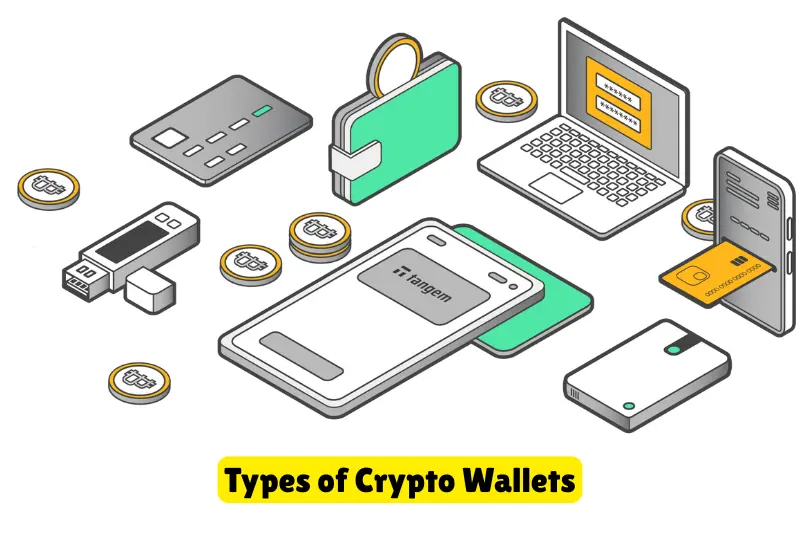
When you step into the crypto world, one of the first decisions you will face is choosing the right type of wallet. Not all wallets are the same. Each type serves a different purpose, and your choice depends on how you plan to use your cryptocurrency. Broadly, wallets are divided into two categories: hot wallets and cold wallets.
Hot Wallets Explained
Hot wallets are connected to the internet. They are convenient for everyday transactions but carry a higher risk of hacking compared to offline wallets.
1. Mobile Wallets
- Mobile wallets are apps that you install on your smartphone.
- They are user-friendly and make it easy to send or receive crypto on the go.
- These wallets are ideal for people who use cryptocurrency regularly for payments or trading.
2. Web Wallets
- Web wallets work directly in your browser.
- You can access them by logging in from any device with an internet connection.
- They are convenient but less secure since the private keys are often stored online.
3. Desktop Wallets
- Desktop wallets are software applications installed on your computer.
- They provide more control and security than web wallets, especially if your computer is well protected.
- They are suitable for people who want a balance between convenience and safety.
Cold Wallets Explained
Cold wallets are offline wallets. Since they are not connected to the internet, they are much safer from online threats. They are best for long-term storage of crypto assets.
1. Hardware Wallets
- Hardware wallets are physical devices designed to store private keys offline.
- They provide one of the highest levels of security in the crypto world.
- Even if your computer is infected with malware, your funds remain safe.
2. Paper Wallets
- A paper wallet is simply a printed copy of your private and public keys.
- Since it is offline, it is not exposed to cyber attacks.
- The challenge with paper wallets is keeping them safe from physical damage or loss.
Both hot and cold wallets have their strengths. Hot wallets are great for active use, while cold wallets are perfect for long-term security. The best approach for many users is to combine both. Keep a small amount of crypto in a hot wallet for daily use, and store the bulk of your assets in a cold wallet Which one is better.
Step-by-Step-Guide: How Does a Crypto Wallet Work?
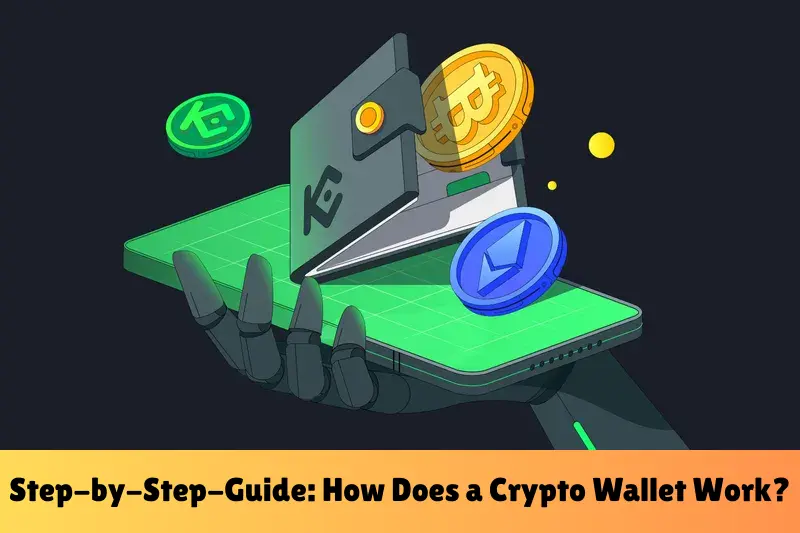
A crypto wallet might sound complicated at first, but if you break it down step by step, it becomes much easier to understand. The wallet does not physically store your cryptocurrency. Instead, it stores the keys that give you access to your coins on the blockchain. Here is a simple explanation of how it all works.
Step 1: Understanding Public and Private Keys
- Every crypto wallet generates two keys: a public key and a private key.
- The public key is like your bank account number. You share it with others when you want to receive crypto.
- The private key is like your secret pin code. It gives complete control over your funds and must be kept safe at all times.
Step 2: Generating Your Wallet
- When you create a wallet, it automatically generates these keys for you.
- The wallet also gives you a seed phrase, which is a backup of your private key.
- If you lose your wallet, you can recover your funds using this seed phrase.
Step 3: Making a Transaction
- To send cryptocurrency, you enter the receiver’s public key and the amount you want to send.
- The wallet signs the transaction with your private key, proving that you are the owner of the funds.
- The transaction is then broadcasted to the blockchain network.
Step 4: Verifying on the Blockchain
- Once the transaction is sent, miners or validators on the blockchain check and confirm it.
- After confirmation, the blockchain updates and shows that the funds have been transferred to the receiver’s wallet.
- This process usually takes a few seconds to several minutes depending on the network.
Step 5: Receiving Funds
- To receive crypto, you only need to share your public key.
- When someone sends funds, the transaction is added to the blockchain, and your wallet shows the updated balance.
- You do not need to be online to receive funds. As soon as the transaction is confirmed, your wallet will reflect it.
Step 6: Security Role of the Wallet
- The main role of the wallet is to secure your private key.
- Even though your funds are on the blockchain, access is only possible through your wallet keys.
- Without your private key, nobody can move your funds.
In simple words, a crypto wallet works as a digital key manager. It gives you the tools to send, receive, and secure your digital money while interacting with the blockchain safely.
You may also like it.
How to Buy Crypto Safely in 2025: Complete Guide – Coinsify
Bitcoin vs Ethereum: Key Differences Explained: Complete Guide
Ultimate Blockchain Glossary: Learn Blockchain Terms Easily
FAQs on How a Crypto Wallet Works
Does a crypto wallet actually hold my coins?
No, the wallet does not hold your coins directly. Your cryptocurrency always lives on the blockchain. The wallet stores your private keys which give you access to your coins and allow you to move them.
What happens if I lose my wallet?
If you lose your wallet, you can still recover your funds using the seed phrase that was given when you first created the wallet. Without the seed phrase or private key, it is impossible to get your crypto back.
Can I use one wallet for different cryptocurrencies?
Yes, many wallets allow you to store multiple types of cryptocurrencies in one place. However, some wallets only support specific coins. It is important to check before choosing a wallet.
Is a hot wallet safe to use?
Hot wallets are safe for small amounts or daily use, but since they are connected to the internet, they carry higher risks. If you are holding a large amount of cryptocurrency, a cold wallet is safer.
Do I need a wallet to buy cryptocurrency?
Most exchanges give you a basic wallet when you buy crypto, but you do not fully control it. To have true ownership of your funds, you need to move your cryptocurrency into a personal wallet where you hold the private keys.
Conclusion
A crypto wallet is your key to the digital currency world. It gives you control, security, and freedom to manage your own money without depending on banks or exchanges. By understanding how it works and keeping your private keys safe, you can explore cryptocurrency with confidence. Whether you choose a hot wallet for quick access or a cold wallet for long-term safety, the most important part is taking charge of your assets.
Bonus Points About Crypto Wallets
- Always write down your seed phrase on paper and keep it in a safe place instead of storing it on your phone or computer.
- Use two factor authentication for extra security when available.
- Keep a small amount of crypto in your hot wallet for daily use and store the majority in a cold wallet for long term safety.
- Regularly update your wallet app or software to get the latest security features.
- Double check wallet addresses before sending funds because transactions cannot be reversed.
- Educate yourself about phishing attacks to avoid fake websites or apps pretending to be wallets.
You may also like it.
How to Buy Bitcoin Safely (Complete Beginner’s Guide)
Top 10 Crypto Wallets for Beginners (2025 Edition)
Best Crypto Wallet Security Tips – Protecting Your Digital Assets
